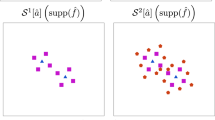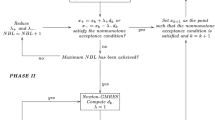Summary
We compare both numerically and theoretically three techniques for accelerating the convergence of a nonlinear fixed point iterationu→T(u), arising from a coupled elliptic system: Chebyshev acceleration, a second order stationary method, and a nonlinear version of the Generalized Minimal Residual Algorithm (GMRES) which we call NLGMR. All three approaches are implemented in ‘Jacobian-free’ mode, i.e., only a subroutine which returnsT(u) as a function ofu is required.
We present a set of numerical comparisons for the drift-diffusion semiconductor model. For the mappingT which corresponds to the nonlinear block Gauß-Seidel algorithm for the solution of this nonlinear elliptic system, NLGMR is found to be superior to the second order stationary method and the Chebychev acceleration. We analyze the local convergence of the nonlinear iterations in terms of the spectrum σ[T u (u (*))] of the derivativeT u at the solutionu (*). The convergence of the original iteration is governed by the spectral radius ϱ[T U (u (*))]. In contrast, the convergence of the two second order accelerations are related to the convex hull of σ[T u (u (*))], while the convergence of the GMRES-based approach is related to the local clustering in σ[I−T u (u (*))]. The spectrum σ[I−T u (u (*))] clusters only at 1 due to the successive inversions of elliptic partial differential equations inT. We explain the observed superiority of GMRES over the second order acceleration by its ability to take advantage of this clustering feature, which is shared by similar coupled nonlinear elliptic systems.
Similar content being viewed by others
References
van der Sluis, A., van der Vorst, H.A. (1984): The rate of convergence of conjugate gradients. Tech. Rep. 354, Utrecht University, Mathematics Dept., Utrecht, The Netherlands
Agmon, S. (1965): Elliptic Boundary Value Problems. Van Nostrand, Toronto New York London
Arnoldi, W. (1951): The principle of minimized iteration in the solution of the matrix eigenvalue problem. Quart. Appl. Math.9, 17–29
Bank, R., Coughran, W., Driscoll, M., Fichtner, W., Smith, R. (1988): Iterative methods in semiconductor simulation. Tech. Rep. Numerical Analysis Manuscript 88-10, AT&T Bell Laboratories
Bank, R.E., Rose, D.J. (1981): Global Approximate Newton Methods. Numer. Math.37, 279–295
Bank, R.E., Rose, D.J., Fichtner, W. (1983): Numerical Methods for Semiconductor Device Simulation. SIAM J. Scient. Statist. Comput.4, 416–435
Brown, P., Saad, Y.: Hybrid GMRES methods for nonlinear systems of equations. In preparation
Brown, P.N. (1987): A local convergence theory for combined inexact-Newton/finite difference projection methods. SIAM J. Numer. Anal.24, 407–434
Brown, P.N., Hindmarsh, A.C. (1986): Matrix-free methods for stiff systems of odes. SIAM J. Numer. Anal.23, 610–638
Brown, P.N., Hindmarsh, A.C. (1986): Reduced-storage matrix methods in stiff ode systems. Tech. Rep. UCLR-95088, Comp. and Math. Res. Div., L-316, Lawrence Livermore Lab., Livermore, Ca., USA
Chan, T., Jackson, K. (1984): Nonlinearly Preconditioned Krylov Subspace Methods for Discrete Newton Algorithms. SIAM J. Stat. Sci. Comput.7, 533–542
Chatelin, F. (1983): Spectral Approximation of Linear Operators. Academic Press, New York San Francisco London
Cullum, J., Willoughby, R. (1984): A lanczos procedure for the modal analysis of very large nonsymmetric matrices. In: Proceedings of the 23rd Conference on Decision and Control, Las Vegas
Dembo, R., Eisenstat, S., Steihaug, T. (1982): Inexact Newton Methods. SIAM J. Numer. Anal.18, 400–408
Dennis, Jr., J., Schnabel, R.B. (1983) Numerical Methods for Unconstrained Optimization and Nonlinear Equations. Prentice-Hall, Englewood Cliffs
Eriksson, L.E., Rizzi, A. (1983): Analysis by computer of the convergence of discrete approximations to the Euler equations. In: Proceedings of the 1983 AIAA conference, Denver, AIAA paper number=83-1951, pp. 407–442
Fischer, B., Freund, R. (1991): Chebychev Polynomials are Not Always Optimal. J. Approx. Theory65, 261–272
Gear, C., Saad, Y. (1983): Iterative solution of linear equations in ode codes. SIAM J. Sci. Stat. Comput.4, 583–601
Gummel, H. (1964): A Self-Consistent Iterative Scheme for One-Dimensional Steady State Transistor calculations. IEEE Trans. Elec. Dev.ED-11, 455–465
Gutknecht, M., Niethammer, W., Varga, R. (1986): K-Step Iterative Methods for Solving Nonlinear Systems of Equations. Numer. Math.48, 699–712
Hageman, L.A., Young, D.M. (1981): Applied Iterative Methods. Academic Press, New York San Francisco London
Hyman, J., Manteuffel, T. (1983): Dynamic acceleration of nonlinear processes. Preprint
Jennings, A., Aziz, M.A. (1977): Influence of the eigenvalue spectrum on the convergence rate of the conjugate gradient method. J. Inst. Math. Appl.20, 61–72
Jennings, A., Stewart, W. (1981): A simultaneous iteration algorithm for real matrices. ACM, Trans. Math. Software,7, 184–198
Jerome, J.W. (1985): Consistency of Semiconductor Modelling: An Existence/Stability Analysis for the Stationary van Roosbroeck System. SIAM J. Appl. Math.45, 565–590
Jerome, J.W. (1985): The Role of Semiconductor Device Diameter and Energy-Band Bending in Convergence of Picard Iteration for Gummel's Map. IEEE Trans. Elec. Dev.ED-32, 2045–2051
Jerome, J.W., Kerkhoven, T. (1991): The Steady State Drift-Diffusion Semiconductor Model. SIAM, Philadelphia
Jesperson, D., Buning, P. (1985): Accelerating an iterative process by explicit annihilation. SIAM J. Sci. Stat. Comput.6, 639–651
Kerkhoven, T. (1985): Convergence of Gummel's Algorithm for Realistic Device Geometries. In: J.J.H. Miller, ed., Proc. NASECODE IV Conference. Boole Press, Dublin, Ireland
Kerkhoven, T. (1986): A Proof of Convergence of Gummel's Algorithm for Realistic Boundary Conditions, SIAM J. Numer. Anal.23, 1121–1137
Kerkhoven, T. (1988): A Spectral Analysis of the Decoupling Algorithm for Semiconductor Simulation. SIAM J. Numer. Anal.25, 1299–1312
Kerkhoven, T. (1988): On the Effectiveness of Gummel's Method. SIAM J. Scient. Statist. Comput.9, 48–60
Kerkhoven, T., Galick, A.T., Ravaioli, U., Arends, J.H., Saad, Y. (1990): Efficient Numerical Simulation Of Two Dimensional Quantum Wells. J. Appl. Phys., 3461–3469
Kitchen, Jr., J. (1966): Concerning the Convergence of Iterates to Fixed Points. Studia mathematicaXXVII, 247–249
Laux, S.E., Stern, F. (1986): Electron states in narrow gate-induced channels in Si. Appl. Phys. Lett.49, 91–93
Laux, S.E., Warren, A.C. (1986): Self-consistent calculation of electron states in narrow channels. Tech. Rep., IBM, T.J. Watson Research Center
Manteuffel, T. (1985): An iterative method for solving nonsymmetric linear systems with dynamic estimation of parameters. Tech. Rep. UIUCDCS-75-758, University of Illinois at Urbana-Champaign, Urbana Ill., Ph.D. dissertation
Mock, M. (1972): On Equations Describing Steady-State Carrier Distributions in a Semiconductor Device. Comm. Pure Appl. Math.25, 781–792
Ortega, J., Rheinboldt, W. (1970): Iterative Solution of Nonlinear Equations in Several Variables. Academic Press, New York San Francisco London
Saad, Y. (1980): Variations on arnodi's method for computing eigenelements of large unsymmetric matrices. Linear Algebra Appl.34, 269–295
Saad, Y. (1982): Projection methods for solving large sparse eigenvalue problems. In: Pitea Havsbad, B. Kagstrom, A. Ruhe, eds., Matrix Pencils. Proceedings. University of Umea, Sweden, Lecture Notes in Math. Series, No. 973. Springer, Berlin Heidelberg New York, pp. 121–144
Saad, Y., Schultz, M.H. (1986): GMRES: A Generalized Minimal Residual Method for solving Nonsymmetric Linear Systems. SIAM J. Sci. Stat. Comput7, 856–869
Scharfetter, D., Gummel, H. (1969): Large signal analysis of a silicon read diode oscillator. IEEE Trans. Elec. Dev.ED-20, 64–77
Seidman, T.I. (1980): Steady State Solutions of Diffusion-Reaction Systems with Electrostatic Convection, Nonlinear Analysis. Theory, Meth. Appl.4, 623–637
Stewart, G. (1976): Simultaneous iteration for computing invariant subspaces of non-hermitian matrices. Numer. Math.25, 123–136
Strang, G., Fix, G.J. (1973): An Analysis of the Finite Element Method. Prentice-Hall, Englewood Cliffs, N.J.
Taylor, A.E. (1958): Introduction to Functional Analysis. Wiley, London New York
Wigton, L., Yu, D., Young, N. (1985): GMRES Acceleration of computational Fluid Dynamics Codes. In: Proceedings of the 1985 AIAA Conference, Denver




